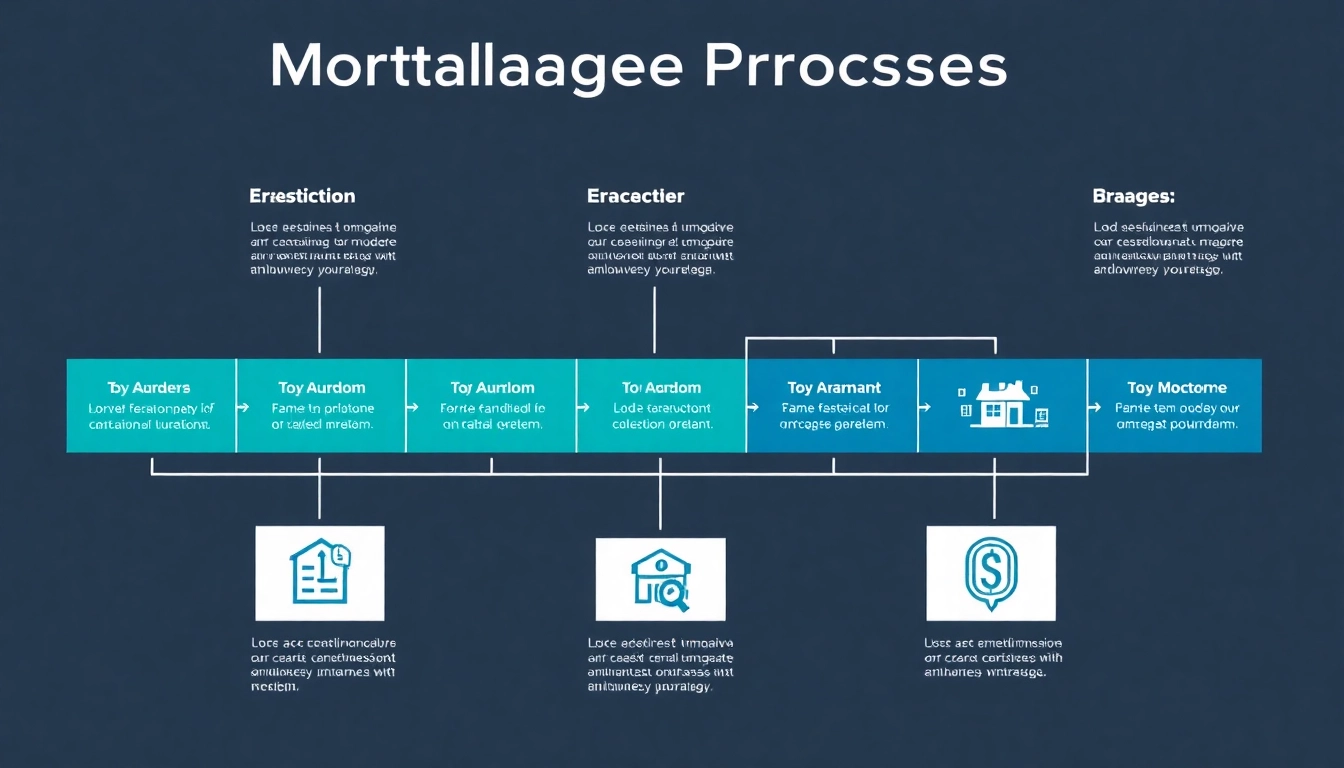Understanding the Mortgage Process for Brokers
The mortgage process can often be complicated, especially for those who are new to the industry or for borrowers looking to finance a home. Brokers play a crucial role in simplifying this process. They act as intermediaries between borrowers and lenders, guiding clients through the myriad steps involved in obtaining a mortgage. Knowing how to navigate this mortgage process for brokers is essential for success in this field. This article will delve deeply into the mortgage process from a broker’s perspective, covering the key stages, best practices, and the challenges brokers may face.
What is a Mortgage Broker?
A mortgage broker is a licensed professional who acts as an intermediary between borrowers and lenders. Unlike loan officers who work directly for a specific bank or credit union, mortgage brokers work with multiple lenders. They assess the unique financial situations of their clients, advising them on suitable mortgage options and helping them navigate the complexities of the mortgage market. Mortgage brokers are compensated through fees from lenders or borrowers, and their role is vital in ensuring better loan terms for their clients.
The Role of Mortgage Brokers in Financing
Mortgage brokers play a multifaceted role in the financing process:
- Assessment of Client Needs: Brokers evaluate the financial backgrounds, needs, and goals of their clients.
- Providing Access to a Variety of Lenders: They give clients access to a range of mortgage products offered by various lenders, which may not be available through traditional banks.
- Guiding Documentation and Requirements: Brokers inform clients about necessary documentation and assist in gathering and submitting required paperwork.
- Negotiating Terms: They negotiate with lenders on behalf of clients to secure the best possible loan terms.
- Facilitating Closing: Brokers help navigate the closing process, ensuring all parties fulfill their obligations for a smooth transaction.
Key Benefits of Using a Mortgage Broker
There are numerous advantages to working with a mortgage broker:
- Expertise and Guidance: Brokers possess extensive market knowledge, enabling them to provide informed advice tailored to individual needs.
- Time Savings: The broker handles much of the legwork, allowing clients to focus on other priorities.
- Better Rates: Through their relationships with lenders, brokers often secure more favorable mortgage rates than borrowers could achieve on their own.
- Personalized Service: The broker offers customized assistance tailored to individual financial situations, enhancing the client experience.
- Support Throughout the Process: They guide clients at every step, reducing the potential for errors and misunderstandings.
Stages of the Mortgage Process for Brokers
Pre-Approval: Setting the Foundation
The first stage in the mortgage process is pre-approval. This crucial step establishes the borrower’s eligibility for a mortgage and gives them a clearer idea of their budget. A broker will typically gather the necessary financial information, such as income, debts, and credit history, and submit this to potential lenders for assessment.
During this stage:
- Borrowers fill out a pre-approval application.
- Credit histories are checked, and financial documents are scrutinized.
- The broker may offer insights into what type of loan products are available based on the borrower’s financial situation.
Achieving pre-approval empowers borrowers in negotiations when house hunting, signaling to sellers that they are serious and financially viable.
Document Collection: Essential Requirements
Following pre-approval, brokers assist clients in gathering the required documentation for a formal loan application. This phase is critical for ensuring all aspects of the borrower’s financial profile are accurately represented to the lender. Typical documents include:
- Proof of income (pay stubs, tax returns)
- Credit reports
- Bank statements
- Employment verification
- Details of assets and liabilities
Exhaustively compiling this information accelerates the loan processing phase and enhances the likelihood of approval.
Loan Application: Navigating the Forms
Once all necessary documents are collected, the broker will assist clients in completing the formal mortgage application. This involves filling out a series of forms required by the lender. Brokers ensure that the information provided is accurate and complete—including aspects such as:
- Personal information and social security number
- Loan amount requested
- Property information
Additionally, brokers facilitate communication between the borrower and the lender, clarifying expectations and timelines.
Best Practices for Brokers in the Mortgage Process
Building Strong Relationships with Lenders
Successful brokers recognize the importance of maintaining robust relationships with a variety of lenders. A diverse lender network allows a broker to offer clients a range of options that suit their specific needs. Strategies for building these relationships include:
- Regularly communicating with lender representatives
- Staying informed about new mortgage products and changes in lending policies
- Offering feedback from clients to lenders to enhance mutual business opportunities
Effective Client Communication Strategies
Clear communication is key throughout the mortgage process. Brokers should prioritize the following strategies:
- Set Expectations: Outlining what clients can anticipate at every step can significantly reduce anxiety and confusion.
- Regular Updates: Frequent check-ins via email or phone can keep clients engaged and informed.
- Educate Clients: Providing insights into mortgage terminology and processes can empower clients, helping them feel more confident in their decisions.
Managing Expectations Throughout the Process
Managing expectations is crucial in mitigating potential frustrations during the lengthy mortgage process. Brokers should:
- Be transparent about timelines related to application reviews, underwriting, and approval.
- Discuss potential hurdles, such as credit issues, and how these may affect the process.
- Encourage clients to remain patient and to ask questions whenever uncertainties arise.
Challenges Faced by Brokers in the Mortgage Market
Common Hurdles During Application Processing
Brokers often encounter multiple challenges during application processing, including:
- Delays in Documentation: Clients may procrastinate or have difficulty gathering the required documents.
- Inconsistent Lender Guidelines: Each lender has different requirements, which can complicate the process and lead to miscommunication.
- Market Volatility: Fluctuations in interest rates and lending habits may impact the options available to borrowers.
Understanding Regulatory Changes
With ever-evolving legislation affecting the mortgage industry, brokers must stay abreast of significant regulatory changes. This requires:
- Ongoing education through industry seminars and workshops.
- Regularly consulting with compliance experts or legal advisors.
- Reviewing periodic updates from regulatory bodies regarding changes in lending laws.
Navigating Market Fluctuations
Market fluctuations pose challenges that can affect clients’ loan options significantly. Brokers must be adaptable, sourcing creative solutions for clients in changing environments. Strategies include:
- Diversifying lender partnerships to encompass a wide array of products.
- Staying alert to promotional programs or temporary rate reductions.
- Continuously monitoring and analyzing market trends to anticipate changes in borrower behavior.
Measuring Success as a Mortgage Broker
Key Performance Metrics to Track
To measure success, brokers should keep a close eye on the following performance metrics:
- Loan Volume: The total amount of loans closed is a primary indicator of business health.
- Approval Rate: Tracking the percentage of applications that successfully close can provide insights into effectiveness.
- Client Acquisition Costs: Understanding how much it costs to acquire a new client helps assess overall profitability.
- Client Retention Rates: High retention rates suggest strong relationships and satisfaction.
Client Satisfaction and Referral Potential
Beyond numbers, client satisfaction plays a significant role in a broker’s success. Positive experiences lead to referrals, which are a vital source of new business. To foster satisfaction:
- Request feedback after closing.
- Implement a referral program rewarding clients who refer others.
- Maintain contact with past clients, with periodic updates on market conditions or valuable insights.
Continuous Education and Skills Development
The mortgage landscape is dynamic, underscoring the necessity for ongoing education. Brokers should:
- Engage in professional development through certifications, courses, and industry conferences.
- Stay updated on emerging trends such as digital mortgage technologies and fintech developments.
- Participate in networking opportunities with industry peers to share insights and strategies.















Leave a Reply